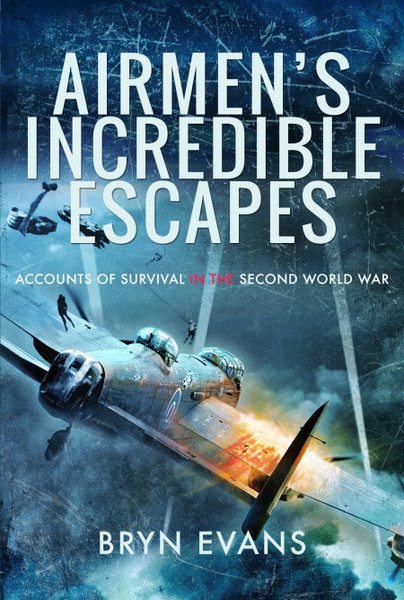Author Guest Post: Bryn Evans
Airmen’s Incredible Escapes
Veterans’ accounts of survival in the Second World War
During the current pandemic front line health workers do their job day after day to save lives, and in doing so many have lost theirs. In the Second World War amidst all the destruction and killing, there were also people everywhere who risked their lives, often losing them to save others. Sometimes, when airmen were shot down and faced unimaginable danger, and hope of survival was near gone, someone stepped forward to help. Such helpers also placed themselves in similar peril or worse, and did so over and over again.
Airmen’s Incredible Escapes, tells of survival in the Second World War against the odds and all probability. They show the amazing resilience of the human spirit. The war in the air was largely unseen except by individual airmen. Death in the sky or in an aircraft crashing to the ground, could come suddenly and in terrifying ways. It was the first ever major war, where the conflict in the air had a decisive influence on the battles on land and sea.
Allied air forces’ aircraft and their crews in all theatres were lost in innumerable encounters and circumstances, and in numbers never seen before or since. New weapons and technologies have made an air war on the scale of the Second World War, with such large numbers of aircraft and airmen on all sides, unlikely to be seen again.
Those airmen who did survive being shot down, and tried to evade capture were sometimes murdered by enemy forces or civilians. Deaths occurred in all kinds of ways, yet some airmen endured the most hostile circumstances. Some with help from selfless strangers evaded capture to journey back to their base over several months. Accounts of such extraordinary survival were often not made known until after the end of the war. Many are known only by veterans, and their families, and have never been recorded or published.
A true appreciation of the ordeals endured by survivors, and of the losses and sacrifices paid by Allied airmen, is difficult to fully comprehend. When so many of us today experience passenger plane travel, it is perhaps possible to imagine, if only with a fleeting sensation, the fear and terror of airmen in an aircraft fatally damaged by enemy fire. The accounts of those who came through the battles in the skies, also give us an insight of the tumult and horrific death inflicted on those who did not survive. In Airmen’s Incredible Escapes, eye-witness accounts paint a vivid picture of those surreal battles in the air, and how some airmen found a way to stay alive.
While a large number of aircrew did survive ‘narrow escape’ experiences, there is no known record of how many this might be, and probably impossible to know. However anecdotal evidence suggests it is significantly higher than the number of casualties. Although over the years many such stories have been published, it is likely that thousands have not. My research has shown that indeed a very large number of veterans’ amazing survival experiences have only ever been known to themselves and their families. By publishing a request for such stories in the media, I received an an unexpected wealth of unpublished accounts from veterans and their families.
First-hand accounts by survivors tell us what they endured in both accident prone training and operations against the enemy. The stories reveal the accumulating fear, terror and stress endured by airmen. Being shot down, making a crash landing, ditching in water, or baling out, was often only the beginning of an unknown ordeal to come. Evading capture by the enemy, staying alive in an inhospitable terrain, in the sea or inland water, enduring the worsening pain from horrendous injuries or wounds, exhaustion, thirst, hunger, followed by the deprivations and cruelties of enemy interrogation and POW camps, these were the nefarious companions for airmen trying to stay alive.
Fate, fortune, good or bad luck, were seemingly random, and ever present. Flying on operations in the Second World War was, as one veteran described it, ‘…dicing with death’.
But unless airmen took to the sky, and were prepared to die, the strategies and grand plans of the Allies’ high commands would amount to nothing.
***
While the air wars against Nazi Germany and its Axis allies in Europe, and the militaristic regime in Japan, comprise the predominant context of these accounts of survival, there was another foe that airmen had to fight and keep at bay.
Aircrew, particularly those based in Britain, experienced a unique double life, very different to servicemen in front line units of the army and navy. When not on duty airmen were free to socialise in the community near to their base, often in the UK with family and close friends. Yet they were continually leaving that normality of civilian life, to fight to the death against an enemy in the sky. Within hours of leaving a convivial social gathering, they would be in a life or death struggle in the air, often shot down over enemy occupied territory, where at times they were summarily executed.
Their life was split between attempts to develop normal relationships with civilians, and flying operations which led to adrenaline-pumping encounters with enemy aircraft and anti-aircraft fire, that on so many occasions ended their lives. For aircrew two personalities fought for dominance of their psyche. In varying degrees it brought about split personalities, and in essence these were not dissimilar from a ‘Dr Jekyll and Mr Hyde’ effect.
Many airmen who did survive the war carried chronic physical injuries into their subsequent lives. Perhaps even more suffered long term psychological conditions, once termed war neuroses, which today are diagnosed as Post Traumatic Syndrome Disease (PTSD). In many cases such psychological effects were undiagnosed, or just not spoken of, but in these veterans’ accounts some such consequences are recognised.
When an aircraft was shot down, an unknown number, while floating down by parachute, were machine-gunned to death by enemy fighters. If aircrew survived baling out, or a crashed landing, life or death remained a lottery. They became desperate to evade capture by enemy forces. Many who were taken prisoner on the ground, were summarily executed by enemy forces or their civilian supporters.
Yet amidst the hate, death, destruction, and worldwide misery of the Second World War, humanity’s instinctive kindness, care and selfless generosity towards fellow human beings still thrived, and was found in some most unlikely places. Aircrew brought down in enemy territory were only able to survive with assistance from either local civilians or even from enemy troops.
Each one of the stories in this book of Airmen’s Incredible Escapes, in many different ways, is astounding. Perhaps the most remarkable and wonderful aspect is that so many airmen owed their survival to the help and kindness of perfect strangers, many who gave their help knew that if found out, it would bring death to themselves, their friends and families. In countless cases it did result in capture, torture and execution. The ‘Helpers’ in all countries knew the risks they were taking. Like the airmen they too were hostage to fortune, and their courage was just as incredible.
By using eye-witness accounts of veteran airmen who lived to tell of their experiences, Airmen’s Incredible Escapes recounts just a few of those solitary and unique survival stories, in the air war that was essential for the Allied victory. In this current time of fear and anxiety caused by the pandemic and its grim toll, to read of these accounts of survival, when death could come at any moment, is inspirational for us all.
Bryn Evans
September 2020

You can preorder a copy here.

